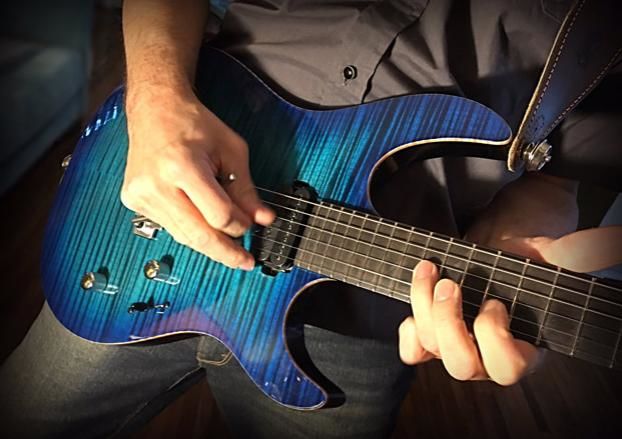More on Developing Proper Sweep Picking Technique
Perfect your sweep picking technique with this lesson.

Sweep picking is an incredibly useful and exciting technique that allows guitarists to perform arpeggios in a flashy, keyboard-like manner.
It has become a huge part of my playing style, and I’m always looking for new and different ways to incorporate sweep picking into musical ideas I come up with. Last month, I detailed the basic mechanics of the technique, and now I’d like to further demonstrate its proper execution.
To review, a sweep is the movement of the pick across two or more adjacent strings in a single, continuous stroke, a downstroke being used to play an ascending melodic line and an upstroke used to play a descending one. Sweeping across only two adjacent strings is also often referred to as economy picking, or rest-stroke picking, typically when applied to phrases that are more scalar than arpeggio-based.
Some of the fastest guitarists ever, from gypsy jazz legend Django Reinhardt to jazz-fusion wizard Frank Gambale, have relied on economy, rest-stroke and sweep picking techniques to perform their breathtaking high-velocity solos and make them sound seemingly effortless.
For now, we’re going to focus specifically on arpeggios that move across the top five strings. FIGURE 1 illustrates a sweep-picked A major arpeggio (A C# E). I begin with my index finger on A, fifth string, 12th fret, and pick this note with a downstroke. I then hammer-on with my pinkie to C# at the 16th fret.
Then, with my middle finger barred across the D, G and B strings at the 14th fret, I continue the initial downstroke by dragging the pick across these strings and then the high E string, using my index finger to fret the E note at the 12th fret. I then fret the high A at the 17th fret with my pinkie and pick that note with an upstroke. I follow this with a pull-off back to the 12th fret then continue the upstroke by dragging the pick across the B, G, D and A strings in one continuous, unbroken motion, followed by a downstroke on the A note on the fifth string’s 12th fret. FIGURE 2 illustrates the complete pattern cycled repeatedly in a continuous, even flow of sextuplets.
An essential component of proper sweep picking technique is muting unused strings with both hands. When sweeping, I always lightly rest the edge of the pick-hand palm across the strings in front of the bridge (what is known as palm muting), which helps prevent the strings not being picked from ringing. Additionally, when fretting on the lower strings, I use the fleshy “paws” of my fretting fingers to mute the adjacent higher strings, aiding in clear articulation of each note as it is picked, with no other strings ringing.
The next step is to work on applying sweeps to other arpeggio shapes in different positions, as demonstrated with a ninth-position A major shape in FIGURES 3–5. When played in this position, a one-note-per-string fingering scheme is used, except on the high E string. FIGURE 3 presents the basic shape, and FIGURE 4 demonstrates one way you can continuously cycle the pattern. I myself usually double-pick the initial A note when repeating this pattern, as shown in FIGURE 5.
A great way to practice your sweeps is to alternate between parallel major and minor triads, such as A and Am. FIGURES 6 and 7 illustrate this approach applied to 12th and ninth positions, respectively.

Get The Pick Newsletter
All the latest guitar news, interviews, lessons, reviews, deals and more, direct to your inbox!










